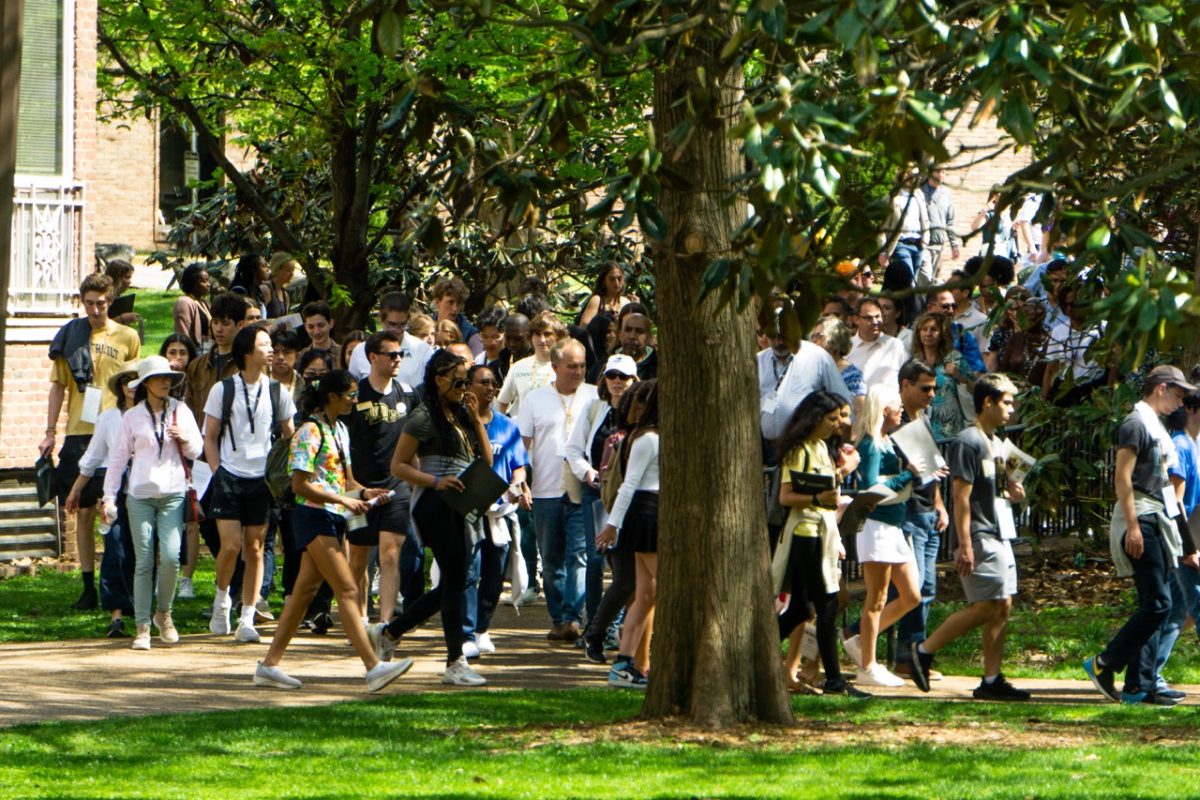
Laura Vaughan
Accepted students pour into the Student Life Center's patio after listening to academic advising sessions, captured April 15, 2023. (Hustler Multimedia/Laura Vaughan)
Vanderbilt’s admission process has recently been subject to examination following the U.S. Supreme Court striking down affirmative action and the university falling on the 2024 U.S. News Best National Universities ranking, which featured a new methodology intended to emphasize social mobility. Dean of Undergraduate Admissions Doug Christiansen spoke to The Hustler about the Class of 2027’s demographics and the university’s admissions process and initiatives in the wake of this scrutiny.
Christiansen said the university’s focus on diversifying its classes has never wavered.
“Our value system was there before SCOTUS came in,” Christiansen said.
Statistics about the Class of 2027 were finalized after the university’s Fall 2023 census. Early decision I applicants received their admission decision on Dec. 14, but Christiansen said statistics about the EDI cycle will not be published separately. EDI and EDII combined statistics will be published in mid-February.
Racial diversity
For the first time in Vanderbilt’s history, Christiansen said more than half — 50.1% — of the undergraduate student body is of an underrepresented minority racial or multiracial background. He added that the percentage of Asian, Black and Latinx undergraduate students has also risen significantly in the past 15 years and since the 2018-19 academic year.
“You really have seen, in the last decade or decade and a half, the complete change in race and ethnicity on campus,” Christiansen said.
In the wake of the SCOTUS decision, Christiansen said the university has continued general and post-admission marketing geared toward students of underrepresented racial identities but has eliminated race as a factor in the admissions process.
“We do lots of work looking at high schools across the country that might have a higher percentage of underrepresented students,” Christiansen said. “[Our admissions officers] have to make sure that they’re in so many underrepresented or low-income high schools. We’ve had that instituted for 10 years.”
Christiansen added that the university will now decide the student invitees to the MOSAIC program after the admissions process, not during. He explained that, through this program, Vanderbilt previously invited a select group of admitted students with diverse backgrounds who have “given a voice to change or to a group who didn’t have a voice” to campus for a recruitment weekend.
Generations of college access
Christiansen said the percentage of first-generation students at Vanderbilt rose one percentage point since last year to 16.6%.
Vanderbilt continues to consider applicants’ legacy status as one of many factors in its admissions process. Some universities, such as Wesleyan University and Carnegie Mellon University, eliminated legacy status in their admissions processes after the Supreme Court ruling, referring to it as a different kind of affirmative action. Others, particularly Ivy League institutions like Harvard University, Cornell University, Dartmouth College and Brown University have received pushback and even been sued over the inclusion of this factor in admissions.
“Spots are not held for legacy; there is no percentage of legacy students that we are looking for,” Christiansen said. “[Being a legacy] would never make an admit decision by itself.”
Christiansen explained that the university’s desire to create a strong community among students supports its consideration of legacy status in the admissions process. Given that legacy status is “such a small part” of the process, Christiansen admitted that continuing to include it in the process raises questions. He declined to comment directly on whether legacy status is deemed “important” by the admissions committee.
“[We are] trying to understand everything about every applicant,” Christiansen said.
Financial inclusivity
Christiansen said 23% of the Class of 2027 are Pell Grant recipients, and 55.1% of the class receive need-based aid, proportions that have been steadily increasing in recent years. He referred to Opportunity Vanderbilt — Vanderbilt’s financial aid program — as an “investment,” rather than an expense.
!function(){“use strict”;window.addEventListener(“message”,(function(a){if(void 0!==a.data[“datawrapper-height”]){var e=document.querySelectorAll(“iframe”);for(var t in a.data[“datawrapper-height”])for(var r=0;r